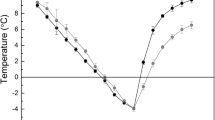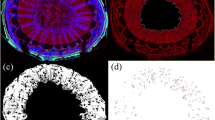Abstract
Grape pruning may lead not only to some physical damages to the xylem vessels but also to the tylose blockage in these vessels. However, there is little information on vessel lumens blockage by tylose decreasing the original capability of sap flow transportation. In present studies, to elucidate the effect of tyloses on both water transport during xylem development and variations in hydraulic conductance with increasing distance of water transport, shoots of three different-shaped vines were evaluated in this study, based on observation of tylose developments and sap flow measurements. The study showed that, for different-shaped vines, sap flow transport distance was significantly associated with quantity of tyloses. Vessels of cordon training (CT) vines had the largest percentage of partly and completely blocked vessels among three different-shaped vines, up to 65.4% and 33.2%, respectively. For renewal crawled cordon training (rCCT) and perennial crawled cordon training (pCCT) vines, shoots of perennial branches (pCCT) had a larger percentage of partly and completely blocked vessels (39.7% and 16.7%, respectively) than shoot of current-year shoots (rCCT vines, 35.6% and 9.3%, respectively). Sap flow rates and sap flow transport distances had a negative correlation for sap flow rates of same-shaped vines. In addition, sap flow rates and sap flow transport distances (namely, number of nodes) and/or quantity of tyloses varied during different-shaped vines. Overall, vessels with few tyloses showed significantly higher values of hydraulic conductance than vessels were completely or partially occluded by more tyloses.



Similar content being viewed by others
References
Beckman C (1987) The nature of wilt diseases of plants. APS Press, St Paul
Beckman CH, Talboys PW (1981) Anatomy of resistance. In: Mace ME, Bell AA, Beckman CH (eds) Fungal wilt diseases of plants. Academic Press, New York, pp 487–521
Bonsen KJM, Kucera LJ (1990) Vessel occlusion in plants: morphological functional and evolutionary aspects. IAWA 11:393–399
Brown GE, Kirkham T, Lancaster R (1995) The pruning of trees, shrubs and conifers. Timber, Portland
Canny MJ (1997) Tyloses and the maintenance of transpiration. Ann Bot 80:565–570
Carlquist SJ (1975) Ecological strategies of xylem evolution. University of California Press, Oakland
Cochard H, Coll L, Roux XL, Améglio T (2002) Unraveling the effects of plant hydraulics on stomatal closure during water stress in walnut. Plant Physiol 128:282–290
Cohen S, Naor A (2002) The effect of three rootstocks on water use, canopy conductance and hydraulic parameters of apple trees and predicting canopy from hydraulic conductance. Plant Cell Environ 25:17–28
Collins BR, Parke JL, Lachenbruch B, Hansen EM (2009) The effects of Phytophthora ramorum infection on the hydraulic conductivity and tylosis formation in tanoak sapwood. Can J For Res 39:1766–1776
Delzon S, Loustau D (2005) Age-related decline in stand water use: sap flow and transpiration in a pine forest chronosequence. Agr For Meteorol 129:105–119
Ford CR, Mcguire MA, Mitchell RJ, Teskey RO (2004) Assessing variation in the radial profile of sap flux density in Pinus species and its effect on daily water use. Tree Physiol 24:241–249
Green SR, Clothier BE, McLeod DJ (1997) The response of sap flow in apple roots to localised irrigation. Agric Water Manag 33:63–78
Greven M, Neal S, Green S, Dichio B, Clothier B (2009) The effects of drought on the water use, fruit development and oil yield from young olive trees. Agric Water Manag 96:1525–1531
Halis Y, Djehichi S, Senoussi MM (2012) Vessel development and the importance of lateral flow in water transport within developing bundles of current-year shoots of grapevine (Vitis vinifera L.). Trees 26:705–714
Jedrzejuk A, Zakrzewski J (2009) Xylem occlusions in the stems of common lilac during postharvest life. Acta Physiol Plant 31:1147–1153
Kang SZ, Hu XT, Du TS, Zhang JH, Jerie P (2003) Transpiration coefficient and ratio of transpiration to evapotranspiration of pear tree (Pyrus communis L.) under alternative partial root-zone drying conditions. Hydrol Process 17:1165–1176
Kitin PB, Fujii T, Abe H, Funada R (2004) Anatomy of the vessel network within and between tree rings of Fraxinus lanuginose (Oleaceae). Am J Bot 91:779–788
Leuzinger ST, Krner C (2007) Water savings in mature deciduous forest trees under elevated CO2. Glob Change Biol 13:1–11
Liu XZ, Kang SZ, Li FS (2009) Simulation of artificial neural network model for trunk sap flow of Pyrus pyrifolia and its comparison with multiple-linear regression. Agric Water Manag 96:939–945
Lu P, Muller WJ, Chacko EK (2000) Spatial variations in xylem sap flux density in the trunk of orchard-grown, mature mango trees under changing soil water conditions. Tree Physiol 20:683–692
McElrone AJ, Grant JA, Kluepfel DA (2010) The role of tyloses in crown hydraulic failure of mature walnut trees afflicted by apoplexy disorder. Tree Physiol 30:761–772
Meuser J, Frensch J (1998) Hydraulic properties of living late metaxylem and interactions between transpiration and xylem pressure in maize. J Exp Bot 49:69–77
Mitchell PJ, Veneklaas E, Lambers H, Burgess SSO (2009) Partitioning of evapotranspiration in a semi-arid eucalypt woodland in south-western Australia. Agric For Meteorol 149:25–37
Moreno F, Fernandez JE, Clothier BE, Green SR (1996) Transpiration and root water uptake by olive trees. Plant Soil 184:85–96
Morton L (2000) Viticulture and grapevine declines: lessons of black goo. Phytopathol Mediterr 39:59–67
Muhammad AF, Sattle R (1982) Vessel structure of Gnetum and the origin of angiosperms. Am J Bot 69:1004–1021
Mundy DC, Manning MA (2011) Physiological response of grapevines to vascular pathogens: a review. N Z Plant Prot 64:7–16
Parameswaran N, Knigge H, Liese W (1985) Electron microscopic demonstration of a suberised layer in the tylosis wall of beech and oak. IAWA Bull 6:269–271
Parke JL, Oh E, Voelker S, Hansen EM, Buckles G, Lachenbruch B (2007) Phytophthora ramorum colonizes tanoak xylem and is associated with reduced stem water transport. Am Phytopathol Soc 97:1558–1567
Pataki DE, Oren R (2003) Species differences in stomatal control of water loss at the canopy scale in a mature bottomland deciduous forest. Adv Water Resour 26:1267–1278
Ranjani K, Krishnamurthy KV (1988) Tyloses of the root wood of Cassia fistula L. Feddes Repert 99:147–149
Ruzin SE (1999) Plant microtechnique and microscopy. Oxford University, New York, p 322
Saitoh TJ, Ohtani J, Fukazawa K (1993) The occurrence and morphology of tyloses and gums in the vessels of Japanese hardwoods. IAWA 14:359–371
Sakuratani T (1981) A heat balance method for measuring water flux in the stem of intact plants. J Agric Meteorol 37:9–17
Salleo S, Nardini A, Gullo MAL, Ghirarrdelli LA (2002) Changes in stem and leaf hydraulics preceding leaf shedding in Castanea sativa L. Biol Plantarum 45:227–234
Schepper VD, Steppe K, Labeke MCV, Lemeu R (2010) Detailed analysis of double girdling effects on stem diameter variations and sap flow in young oak trees. Environ Exp Bot 68:149–156
Schmitt U, Liese W (1993) Response of xylem parenchyma by suberization in some hardwoods after mechanical injury. Trees 8:23–30
Schulte PJ, Renée Brooks R (2003) Branch junctions and the flow of water through xylem in Douglas-fir and ponderosa pine stems. J Exp Bot 54:1597–1605
Scott PC, Miller LW, Webster BD, Leopold AC (1967) Structural changes during bean leaf abscission. Am J Bot 54:730–734
Sellami MH, Sifaoui MS (2003) Estimating transpiration in an intercropping system: measuring sap flow inside the oasis. Agric Water Manag 59:191–204
Shang NK (2011) Negative pressure transport mechanism of long-distance water transport in trees. Shandong For Sci Technol 3:90–92
Sun YL, Shen FY (2008) Study on dissection structure and contact angle of vessels between nodes and internodes in three kinds of trees. J Anhui Agric Sci 36:7131–7132
Sun Q, Rost TL, Matthews MA (2006) Pruning-induced tylose development in stems of current-year shoots of Vitis vinifera (Vitaceae). Am J Bot 93:1567–1576
Sun Q, Rost TR, Matthews MA (2008) Wound-induced vascular occlusions in Vitis vinifera (Vitaceae): tyloses in summer and gels in winter. Am J Bot 95:1498–1505
Sun Q, Sun YL, Walker MA, Labavitch JM (2013) Vascular occlusions in grapevines with Pierce’s disease make disease symptom development worse. Plant Physiol 161:1529–1541
Taneda H, Tateno M (2007) Effects of transverse movement of water in xylem on patterns of water transport within current-year shoots of kudzu vine, Pueraria lobata. Funct Ecol 21:226–234
Wang HT, Zhao WF, Ma LY (2006) Spatial variation of sap flow of Platycladus orientalis and it’s affecting factors. Sci Silv Sin 42:2127
Webster BD (1973) Anatomical and histochemical changes in leaf abscission. In: Kozlowski TT (ed) Shedding of plant parts. Academic Press, New York, pp 45–83
Wilson KB, Hanson PJ, Mulholland PJ, Baldocchi DD, Wullschleger SD (2001) A comparison of methods for determining forest evapotranspiration and its components: sap-flow, soil water budget, eddy covariance and catchment water balance. Agric For Meteorol 106:153–168
Wu CN (1989) The discussion on the problem of water rise to the tops of the trees. Zhejiang For Sci Technol 9:63
Wullschleger SD, King AW (2000) Radial variation in sap velocity as a function of stem diameter and sapwood thickness in a yellow-poplar tree. Tree Physiol 20:511–518
Zhang DW, Shi FC (2004) Morphological anatomical studies on Betulaceae vessel element from Heilong Jiang Prov. China. Bull Bot Res 24(2):158–161
Acknowledgements
This project was supported by Shandong Province Natural science Fund (ZR2015CL038) and Tai’an city’s Science and Technology Development Project (2017GX0058), and the authors also thank Technology extension service center of forest and fruit industries in Turpan for their kindly support.
Author information
Authors and Affiliations
Contributions
XHZ designed the study; XHZ, LYL and CXL conducted laboratory experiments; XHZ and CXL analyzed the data; XHZ and LYL wrote the manuscript; and LYL reviewed the manuscript. HL supervised the research project.
Corresponding author
Additional information
Publisher's Note
Springer Nature remains neutral with regard to jurisdictional claims in published maps and institutional affiliations.
Rights and permissions
About this article
Cite this article
Zhao, X., Liu, L., Li, C. et al. Water transport distance’s effect on tylose development and sap flow in Meili grapevine. Braz. J. Bot 42, 261–269 (2019). https://doi.org/10.1007/s40415-019-00523-4
Received:
Accepted:
Published:
Issue Date:
DOI: https://doi.org/10.1007/s40415-019-00523-4




